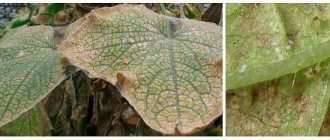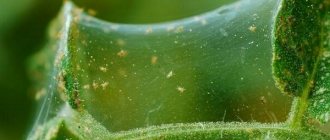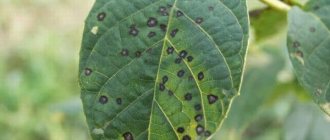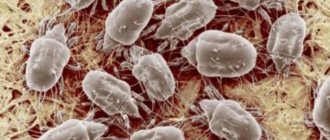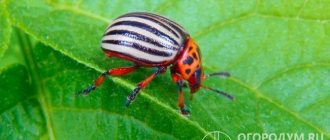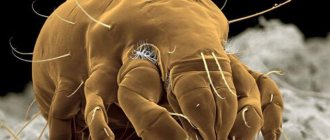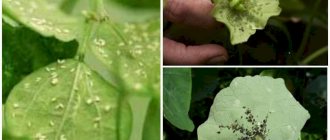- What is a spider mite and how does it reproduce? Life cycle of a spider mite.
- How are spider mites harmful to the plant?
- How can you tell if a plant is infected with spider mites? Symptoms of spider mites.
- How to treat a plant for spider mites? Means to combat spider mites.
- Fighting spider mites in the apartment.
- Folk remedies in the fight against spider mites. My processing scheme.
- Pros and cons of my scheme.
Now has come that time of year when even a tick can easily be “inflated” into an apartment by the wind from an open window.
Those who have trees near their windows/balconies are especially susceptible to this. Also, ticks can be “airborne” from neighbors above, because they are so light that they are carried by the wind like specks of dust. They can be brought in with a newly purchased plant, if it is not first quarantined. The biggest problem is fighting the tick, so, of course, it is better to prevent this matter.
I haven’t had any problems with mites for several years, since we moved to a new apartment, but this year I discovered a cobweb on the rose, and upon a detailed examination of the plants next to it, I also noticed disgusting living creatures.
What is a spider mite and how does it reproduce? Life cycle of a spider mite.
Spider mites are small insects whose size does not exceed 0.5 mm. It is very difficult to notice on a plant because with a small number of individuals, they rarely give themselves away, since they are very small and sit on the opposite side of the leaf. And even if we notice some dark grains, we most likely attribute it to careless watering and grains of soil getting onto the leaf. As a rule, the characteristic appearance of cobwebs means only one thing - there are too many ticks and they need to be dealt with immediately.
The tick reproduces very quickly: under favorable conditions, the female lays up to 250-300 eggs in 2-3 weeks, after which she dies. Favorable conditions for the development of spider mites are dryness and high temperature. The development cycle of a spider mite includes the following stages: egg, larva, protonymph, deuteronymph (in females), and adult. As a rule, from the very first stage (egg) to the adult individual it takes from 10 to 20 days, all other things being equal. So how does a mite harm a plant?
What does it look like
It is quite difficult to see it with the naked eye. Biologists classify it as arachnid, a type of arthropod. This is due to the structure of the body - it has several legs (in adults - 8, in larvae - 6), which makes it vaguely similar to a spider.
Color varies from pale, greenish-yellow, translucent. Internal organs are visible, they look just like dark spots on the back. But there are other types that are more noticeable in color, such as bright red.
Adult females acquire an orange and reddish hue closer to winter, which makes them easier to detect on the plant. They have small “claws” on their legs that help them attach to leaves.
Ticks spin a thin web in which both adults and larvae live. The life cycle of each tick is up to 50 days.
How are spider mites harmful to the plant?
The spider mite is a living creature; it tends not only to reproduce, but also to feed. What does a spider mite eat? Everything is very simple, it feeds on the sap of the plant, piercing the leaf with its proboscis and releasing enzymes into it that destroy the chloroplasts of the cells.
As a result, the leaf becomes covered with brown dots, which soon merge into one large area, then the leaf dries out and falls off. From all this we can clearly conclude that the plant eventually loses its leaves and dies. And the mites will safely migrate to another neighboring plant.
Important! You should not think that the mite will sit only on the bottom of the plant until it is completely exhausted. There is a 99% chance that if you find a mite on one plant, it has already spread throughout the entire windowsill.
Signs of a pest
Such microscopic pests are extremely difficult to see with the naked eye. But, after carefully examining the indoor plant, you can see characteristic damage on the foliage. The fact is that spider mites leave punctures on flowers that can be seen in the light. After some period of time, these small holes begin to merge and form large spots, and the damaged leaf itself begins to dry out.
The flower stops growing and its foliage turns pale. If the plant is covered with cobwebs, this indicates a strong infestation of pests on it. This case requires immediate intervention, otherwise spider mites will simply destroy all the vegetation in the apartment.
Another sign of the presence of spider mites on indoor plants is signs of shedding that look like dandruff. In addition, they leave behind a discharge in the form of silvery stripes and spots on the leaves. A magnifying glass will help you make sure that the flower is affected by a mite. Through it, you should carefully examine the diseased plant. It is best to do this in sunlight, since in artificial light the parasites may be invisible.
How can you tell if a plant is infected with spider mites? Symptoms of spider mites.
Let's look at the so-called symptoms of spider mite infestation. Unfortunately, the primary symptoms are nonspecific, so the tick is detected already when an obvious web appears.
- The appearance of brown spots on the leaves, as if the leaves were pierced with a thin needle.
- The presence of drying leaves on the plant, falling buds.
- Slowing down the development of the plant and its growth.
- Black or tan spots on the back of leaves that move.
- A web that weaves around parts of a plant and the underside of leaves.
- A cluster of individuals on a web (with a huge population).\
How to treat a plant for spider mites? Means to combat spider mites.
Of course, there are a large number of drugs that guarantee almost complete elimination of spider mites - these are the so-called acaricides and insectoacaricides. Let me make a reservation right away that they are effective not only against ticks, but also against other insect pests.
These drugs are both chemical (for example, Actellik and Fufanon) and biological (for example, Fitoverm and Akarin). Chemical and biological drugs have different active ingredients, but the principle of action is the same.
Both drugs are used three times, with a break of 5-10 days, because during the initial treatment the poison kills adult individuals, but the eggs are resistant to the substance and after a while hatch from the eggs and continue to exist on the plant.
This is interesting! There is also a very serious point that should not be forgotten - even adult mites acquire resistance to any drug over time, so it is recommended to do a control treatment with another drug, and not to treat plants more than once a year.
Important! You should be aware that it is undesirable to use chemicals in an apartment, because they have a negative effect on human health and have a very strong specific odor, the fumes of which are very harmful to inhale.
But what to do, since we are talking specifically about indoor plants, how then to treat the plants if the mite still appears on them?
Types of ticks
This parasite is a representative of arachnids, but belongs to the arthropod species. He received his classification due to his special body structure. Actually, this is why many of the detergents used against it simply remain powerless. To completely destroy this pest, special preparations are required. There are more than 2,000 subspecies of ticks, which are located throughout the planet.
For indoor vegetation, the following types are considered more dangerous:
- Ordinary. This is the most common type of parasite, it is absolutely omnivorous and can infect any plant.
- Red. Gives preference to indoor culture.
- False. It is a microscopic parasite, so it can only be detected when the flower is already on the verge of death, and it withers in just a few days.
- Cyclamen. This mite is localized not only on the bush, but also in the soil, so it is extremely difficult to fight it. It develops rapidly, creating huge colonies that look like ordinary dust. Because of this similarity, it is almost impossible to recognize them at an early stage. They prefer vegetation that is often sprayed and watered.
These representatives of arachnids feed on plant sap. Flowers deprived of this liquid begin to weaken, become sick and die. The danger of these pests is that they are very small in size, making them difficult to detect, especially in the early stages. Even an adult individual grows no more than 1 mm. It has a greenish-brown color that allows it to easily blend in with the leaves. They can usually be found on the outside of foliage.
In addition, the parasite reproduces quite quickly - this cycle is called metamorphosis. It lasts from one to four weeks, depending on the temperature in the room. As soon as the temperature reaches 30 degrees, larvae appear, which after 3 days are already able to reproduce on their own.
Parasites are brought into the house on new, recently acquired flowers or in planting material. Often a tick gets onto a houseplant through an open window, and the number of floors in this case does not play a special role. It is worth noting that females can hibernate under unfavorable climatic conditions for up to 5 years.
Fighting spider mites in the apartment.
Since I try to write absolutely objective articles, it should be said that many gardeners used chemicals in the apartment. For example, in the summer season - on a balcony or loggia, which was then ventilated, and in the winter season - in the bathroom, which was locked at night to prevent contact with poisonous vapors. But keep in mind the fact that when spraying plants, poison will inevitably get on walls, hygiene items, and clothes. Yes, and the whole night the bathroom will be inaccessible to you, but what if you have a shared bathroom and you don’t live alone in the apartment? You can at least ventilate a balcony or loggia without any problems, but with a bathtub in this case it is much more difficult.
For me personally, this is not a solution, since I don’t want my family to suffer from my manipulations, and I only have one health. But with all this, I love my collection too much and giving up was not part of my plans.
Therefore, I have prepared a plan of action for myself, which, in my opinion, is not inferior in effectiveness to chemical treatment, but is absolutely safe for health.
Basic methods of struggle
Fighting spider mites on indoor plants is quite difficult. Various methods are used to resolve this problem. You can use chemicals or time-tested folk remedies. It is worth noting that the first option gives a faster effect, while the second acts slowly, but is safe for the flower itself. Each gardener decides for himself which method to choose.
Application of chemistry
To combat flower mites, special chemicals are used - acaricides. They help get rid of insects quickly and for a long time.
The most effective drugs:
- "Aktelik". An excellent remedy that prevents spiders from feeding on flower sap. It is recommended to spray diseased vegetation twice every 7-10 days. The procedure must be performed in the fresh air. If the lesion is large enough, then after treatment you can cover the flower pot with a plastic bag. When carrying out the event, you must act with extreme caution - the product is considered poisonous.
- "Fitoverm". Another biological drug, but less harmful than the previous one. The composition includes substances such as aversectins, which have neurotoxic properties that have a detrimental effect on the pest.
- "Neoron". The most effective remedy of all presented. It helps to get rid of not only adults, but also to destroy larvae, as well as laid parasite eggs.
- "Skelta." This product is new, but has already gained popularity. The peculiarity of the drug is that the spiders do not die immediately, but over a period of time, infecting the entire colony, including the larvae, in the process. To completely exterminate spider mites on home flowers, one treatment will be enough.
- "Flumite." Helps destroy parasite eggs, as well as prevent the emergence of new ones. Harm is also caused to adults, so the flower will get rid of parasites quickly enough. But the product cannot often be used, this is due to its toxicity.
If you don’t want to harm diseased plants even more, you can use more gentle methods. There are a large number of home remedies that you can use to get rid of ticks.
Folk remedies
First you need to prepare the indoor plant: wash the foliage with warm water or wipe with a damp cloth, remove the white cobwebs.
But it is not recommended to use detergent compositions, as they clog the pores.
In addition, you should clean the window sill and the flowerpot itself. The fact is that these spiders can hide not only in vegetation, but also nearby. Having carried out these steps, you can begin to process the plant itself.
The most effective means to help get rid of the pest are prepared according to the following recipes:
- Garlic tincture. This mixture is quite easy to prepare. You only need a couple of cloves of garlic (insects are extremely negative about the strong smell). Finely chop the slices and pour boiling water over them, then leave for 5 days in a dark place. After the solution is ready, it is diluted with fresh water at a ratio of 1 to 1 and the indoor flower is treated with the liquid.
- Onion tincture. You need 100 grams of onion peels and 5 liters of water. Combine both components, stir and leave to infuse. After five days, the solution is filtered and used for its intended purpose. Used as a means for spraying and wiping.
- Medical alcohol. This option is only suitable for vegetation with thick and dense leaves. It is necessary to moisten a cotton swab or gauze in alcohol and wipe the stems with the solution. Particular care must be taken to treat the outside of the leaf, since insects are localized in these places.
- Laundry soap. This method is especially good in the early stages, when there are not many ticks. As a preventative measure, it is advisable to spray all indoor plants. To make the product, you need to take a small piece of soap and dissolve it in water, or you can simply lather it, apply the resulting foam to the flower and leave it in this state for several hours. The effect will be stronger if you cover the flower bush with a plastic bag.
Don't worry if the spiders don't disappear right away. Folk remedies do not have an immediate effect, but there is no doubt that after several similar procedures the pests will disappear.
Folk remedies in the fight against spider mites. My processing scheme.
Those who, like me, were looking for other ways to fight, I think more than once saw recipes against spider mites based on laundry soap, onion peels, garlic or even dandelion.
You should not be skeptical about these methods, since they help many people quite well, and my scheme is based on one of the above components.
Important! If you have a fairly impressive collection of plants (150 or more specimens), most likely, my method will not suit you. And if you need to process only 1-2 window sills, then the result will pleasantly surprise you.
Let me remind you that chemistry is not an option for me at all, and I was ready to do anything just to avoid poisoning myself and my household with it. Therefore, at first, I tried to follow the advice from the forums and, having treated the plants with a soap solution, wrapped them in a bag for several days (so that the solution would work), but after such treatment the mites came out again. It was stupid to hope that I would get them out the first time, but I still wanted to believe.
I won’t write to you about my torment and different options; I’ll probably move on to the scheme that I arrived at through trial and error.
There are quite a lot of plants in my collection, so I had to ask for help in selling it.
Important! To implement such a plan you will need 2-3 hours a week, depending on the number of copies. If you have a very small number of plants, then the time can be sharply reduced to 20-30 minutes per week.
All you need is laundry soap, water and a soft sponge. No packages needed!
- Transfer infected plants to the bath.
- Be sure to remove and wash the curtains, because... they come into contact with infected plants and may also harbor these pests.
Important! You only need to do this once. Moreover, when treating plants with chemicals, you will also have to wash the curtains if you do not want a relapse.This is interesting! A small life hack for curtains - you can hang them on the windows damp - this way they will dry on the window in their usual state and you won’t have to iron them.
- Fill a basin with warm water and be sure to wash the window and window sill, including glass, handles, etc., with laundry soap.
This is also done 1 time. Then you can do it as you wish, or you can not do it. I just wipe the window sill with soapy water. Important! Do not hang curtains before treating the window! - Now comes the hard part - processing the plants. You need to treat every pot and every plant. This is difficult because I don’t just spray the plants with a soapy solution or place a foam solution on the plant, but I soap a soft sponge so generously that there is a lot of soap and I rub each leaf as much as possible (!), I also rub the trunk, I check several times, so that everything without exception is soaped, I also soap the outside of the pot and a little of the top layer of soil. The first time, when processing, I left the plants in this state for 3-4 hours, the subsequent ones I simply soaped and washed off. Soaping is much easier than rinsing. Personally, it is not difficult for me to soap even a lush exotic ficus (it is not large-leaved). An hour after soaping, there is still a lot of soap on the plants.
Since I had a lot of plants, I had to wash them in parts: while one portion was being washed in the bathroom, the rest were waiting nearby. In this way I treated against ticks: drimiopsis, ficus, hibiscus, indoor rose, sorrel, begonias, fuchsias, chlorophytums, tradescantia, lemons and even mangoes.Important! Be sure to wash the back side of the sheet, because this is where spider mites settle.
Drimiopsis is completely soapy. Even fuchsia crumbs easily survived the soap procedures. The fuchsia buds were not damaged by the soap treatment, and the fuchsia bloomed a couple of days later.
I wash it off like this: I lay the plant carefully on its side, and wash out the soap with a sponge; I also wash off the pot and the top layer of soil (then you can add a new one). I carry out such manipulations with all plants, except thick-skinned ones, which cannot be washed (for example, not my haworthia, because water should not be allowed to get into the outlet). For plants that cannot be washed (for me these are succulents), I treat them with high-quality alcohol and wash the pot with soap.
Important! I wash it off in such a way that the soap does not get on the roots of the plants, otherwise they may die!
- After this, I return the plants to their original place.
But what is the scheme? Everything is very simple. Remember how we discussed the life cycle of a tick above?
So, after a week, there is a possibility that the mites that have not washed off will hatch, so you need to repeat the treatment of the plants and pots. This time I no longer wash the curtains or wash the windows, I just wipe the window sill a little with soapy water. I cover the soil with cling film so that soap does not get on the roots.
Cling film prevents soap from getting on the soil and roots.
It is much easier to wash off plants because the film protects the soil from soapy water.
Important! Such treatments must be carried out once a week for a whole month. That is, such treatment is carried out only 4 times per month. During this month, all ticks and eggs that might be present die and are washed away.
Causes of the parasite
How and where does the parasite get to the plant? There may be the following reasons for this:
- With an infected plant brought from a nursery or store.
Important! When purchasing a new flower, you should immediately examine your pet thoroughly. If there are white or yellow spots on the leaves, you should refuse to purchase.
Advice! Immediately place the new plant for 2 weeks in a separate place, away from other plants. If problems suddenly arise with mites or other insects, other plantings will not be affected.
- With purchased or street soil substrate, humus. Under unfavorable conditions, an insect can hibernate and not reveal itself in any way. At high temperatures and low humidity, the tick wakes up and becomes more active.
Advice! Before using such soil, it must be disinfected using hot temperatures, for example, calcination.
- With the wind, which carries ticks through the air. On an open balcony, the likelihood of picking up a parasite increases.
- With gardeners' clothes. Clinging to a shirt or trousers, an uninvited guest ends up in a garden, greenhouse, or house.
- From plants adjacent to the dacha plot already infected with mites.
Pros and cons of my scheme.
Any method has its advantages and disadvantages, and everyone chooses for himself whether it suits him, weighing the pros and cons.
Pros:
- Absolute safety for both your health and the health of your loved ones.
- A good result is that after a month the probability of relapse is less than 3%.
- Cheapness. One bar of soap is enough for all 4 treatments
Minuses:
- Inability to process large numbers of plants.
- A lot of time, it took me about 1 hour to process 1 window sill.
- Soap deposits on the leaves (can be removed with a damp cloth).
I hope you understand my principle of fighting spider mites.
Healthy plants!
